7 Candlestick Patterns: Every Trader should Know

Candlestick charts has been around for hundreds of years. They are often referred to as "Japanese candles" because the Japanese would use them to analyze the price of rice contracts. A rice trader named Homma from the town of Sakata deserves much of the credit for candlestick development and charting. Over many years of trading, it's likely that his original concepts were altered and improved, eventually leading to the candlestick charting system that we use today. But many of the guiding principles remained the same throughout the years:
- The price action is the supreme parameter and is above the noise(news, earnings, and so on) in the market
- Price is a reflection of the behaviours of the bears and bulls in the market—the underlying assumption will always be based on the fear and greed of the market.
- The actual price may/may not reflect the intrinsic value of the underlying asset
To understand the need and power of candlestick charts, let’s analyse the price action movement of TCS over the last month:
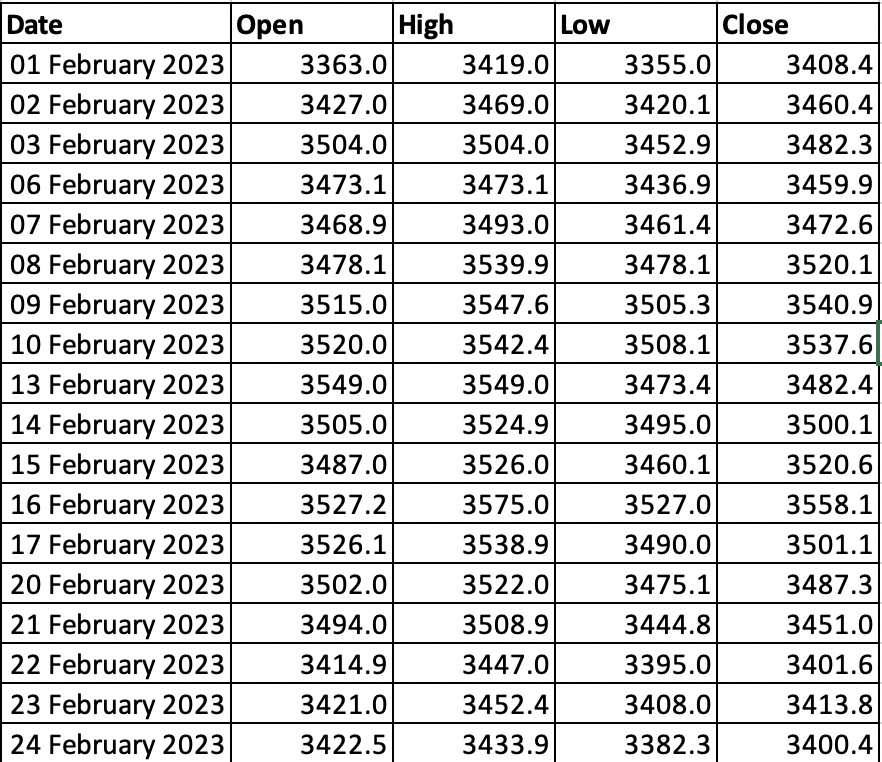
The table above contains the daily reported price movement of TCS from 1st Feb 2023 to 24th Feb 2023.
You have 2 minutes to come to a conclusion by just looking at the above table. What is your analysis? Could you understand the price movement, or could you observe any pattern?
If you are not a maths genius, I would say it would have been very difficult for you to draw any conclusion from all these numbers.
Let’s give it another go, but this time we’ll use the figure below:
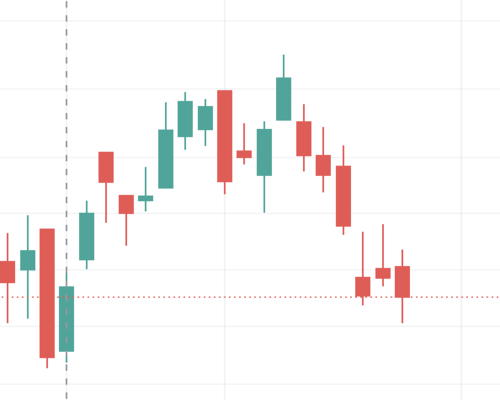
The table and the candlestick chart both are representing the same information: Daily Price movement of TCS in Feb’23, but notice how much easier it is to process information when it is in the form of a chart or picture rather than old boring numbers in a table.
Just a look at the chart, you can easily figure out the road map of where the prices have been and get a sense of the trend the prices have been following in the last 1 month.
Simply put, candlesticks patterns are a way of communicating information about how price is moving. As the name suggests, the candlesticks charts resemble a simple candlestick with a body and wick.

What is a candlestick?
A candlestick displays the open, close, high and low price of the underlying asset for a time period. In a typical candlestick chart, each candlestick represents a specific time period, such as a day, a week, or an hour. The colour of the candlestick can indicate whether the price of the asset rose or fell during that time period. A green or white candlestick indicates that the price rose, while a red or black candlestick indicates that the price fell.
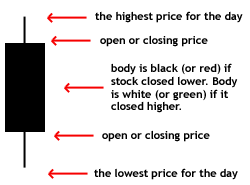
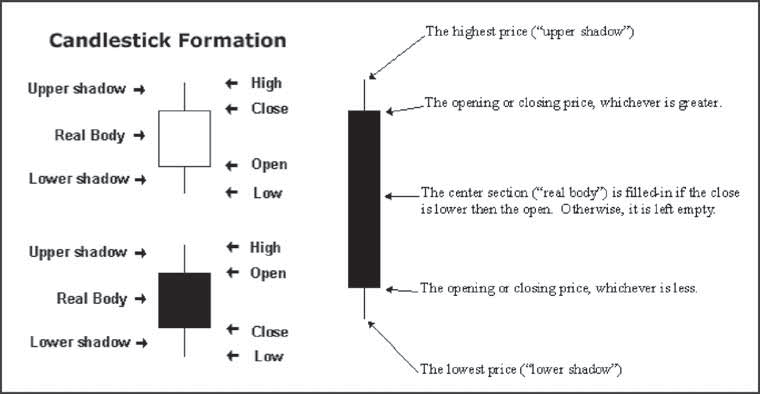
Simply, a candlestick has 5 factors; High, low, close, open and the body. Let's understand these terms using the same example of TCS.
On 1st Feb 2023, TCS’s stock opened at NSE at Rs.3,363. During the day, the price traded in the market naturally deviated from its open price, made a high of 3,419 and even touched 3,355, which was the lowest price at which TCS traded on that day. Finally, when the market closed, TCS's price settled at a close price of 3,408.35.
To sum it up, on 1st Feb 2023, TCS made a :
Open:3,363
High: 3,419
Close: 3,408.4
Low:3,355
The body of the candle or the box represents both the opening and the closing price. If the stock closed at a higher price than it opened, the body is green(white). Conversely, if the closing price falls below the opening price, the body is red (black).
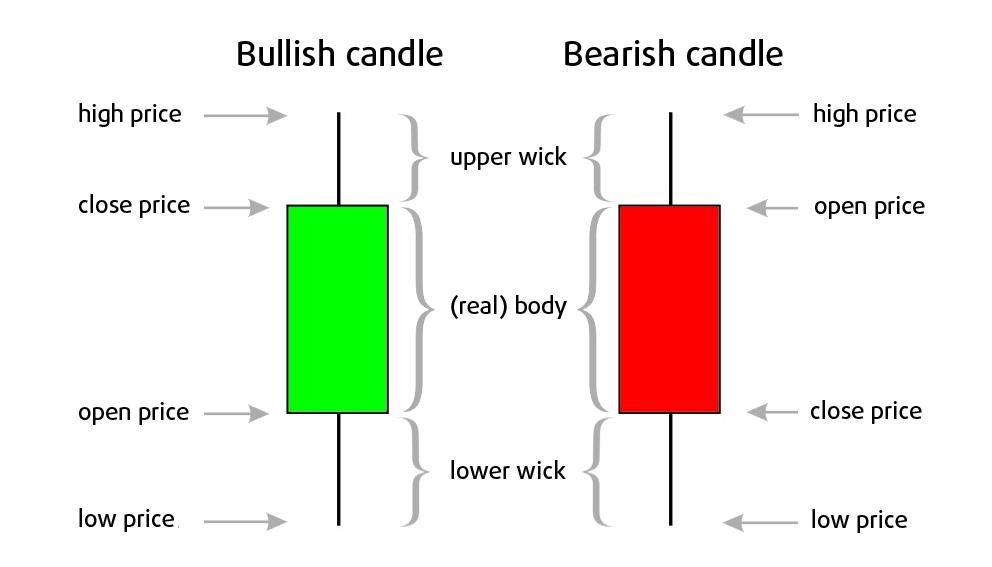
The colour and the length of the body and the shadows/wick convey a snapshot of who’s winning the battle between the bulls and bears.
The thin vertical bars/lines above and below the body of the candle represent the price extremes of the trading session and are called shadows/wicks. The line above the body is called the “upper shadow/wick,” and the line below the candle is called the “lower shadow/wick”. The tip of the upper wick in a bullish candle is the high price, and the tip of the lower wick in a bullish candle is the low price of the trading session of the stock.
Candlestick Patterns
Individual candlesticks can take a variety of forms, some have long bodies, some short wicks/shadows, some have short bodies with long wicks, and so on.
The colour of the body, the size of the wick and the body and where the candle sits relative to the wick tell a lot about the price action that occurs over the time period represented by the candlestick.
Taking the example of the third candlestick in the above TCS chart, we see that this candlestick has almost no upper wick; this, along with the red body, indicates that TCS opened near the high of the day and closed near its lowest price as the lower wick is too far from the closing price.
Whereas the second candlestick in the chart has a relatively small green body and longer wicks, indicating that the price range throughout the day was much greater than the difference between the opening and the closing prices.
Therefore, you can see how well even a single candlestick communicates the “market sentiment”: whether (and to what extent) bears or bulls were in control and how far traders managed to push prices in both directions.
One-candlestick Patterns
1. Hammer
Hammer is a bullish trend reversal single candlestick pattern that forms after a decline in trend. Therefore, it indicates a change in trend, i.e. from a downtrend to an uptrend. It is so named because it hammers out the bottom. The resulting candlestick has a long lower wick with a short body and little to no upper wick.
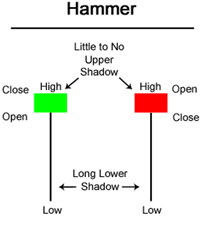
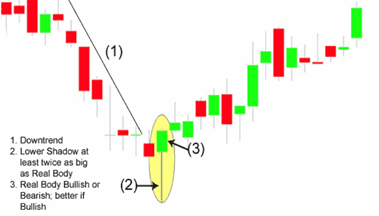
Market view
The long lower wick's low suggests that sellers pushed prices lower throughout the session. The strong finish, on the other hand, suggests that buyers recovered to end the session strongly. Even though it might seem like enough to proceed, hammers need more bullish support. The low of the hammer indicates that there are still many sellers. Before taking action, there needs to be more buying pressure, ideally on an increasing volume. A gap up or a long green candlestick could provide such confirmation.
Criteria
- The lower wick should be at least two times the length of the body.
- There should be no upper wick or a very small upper wick.
- The body is at the upper end of the trading range. The colour of the body is not important, although a green body should have slightly more bullish implications.
- A positive day, i.e. a green candle, is required the next day to confirm this signal.
- The stop loss level is the low of the hammer.
- The open and close of the hammer should be in the same price range. A perfect hammer can have its open=high or open=low with the body being in a small range with a 2x size shadow than its body
Trade setup
- The longer the lower wick, the higher the potential of a reversal occurring.
- Large volume on hammer day increases the chances that a blow-off day has occurred.
- A gap down from the previous day's close sets the stage for a stronger reversal move if the day following the Hammer opens higher.
- Hammers can also be used to indicate support or bottom levels in addition to potential trend reversals.
The below examples are taken from the daily timeframe chart of LTI Mindtree and Maharashtra Scooter
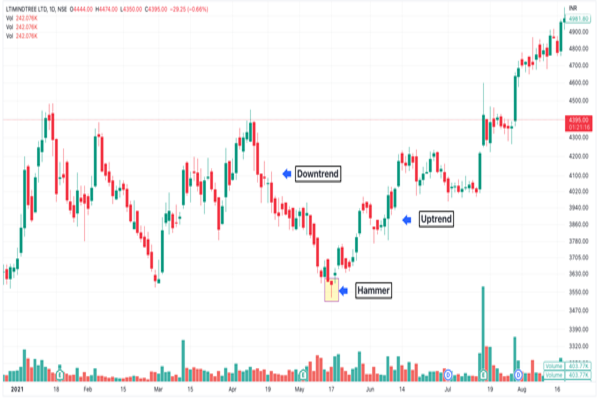
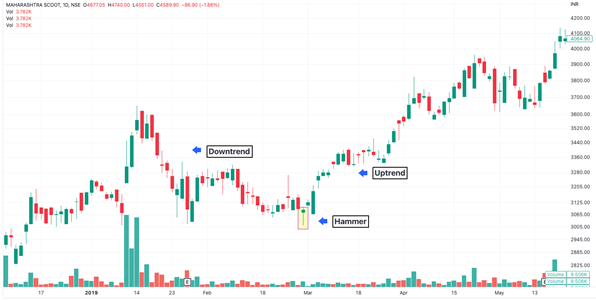
2. Hanging Man
The "hanging man" pattern refers to a candle that has the same shape as a hammer, except that hammers occur in downtrends and the hanging man pattern occurs in uptrends.
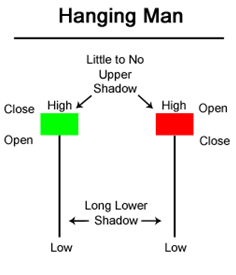
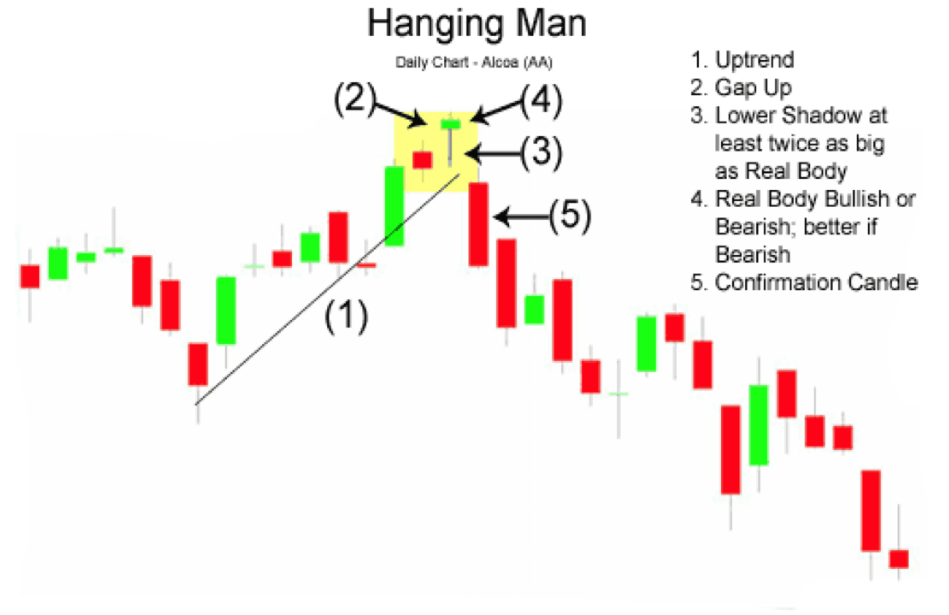
Market view
The hanging man pattern is formed when bulls push prices higher at the open price of a trading session but bear then enter the market and push prices lower. The bulls eventually manage to push prices back up, but they can't maintain the momentum, and prices close near the open. This creates the small real body and long lower wick that characterizes the hanging man pattern.
The hanging man pattern is considered a bearish reversal pattern because it suggests that the bulls are losing control and bears are taking over. It is often interpreted as a signal that the uptrend is weakening and a downtrend may be starting.
Criteria
- The candlestick must have a small real body near the lower end of the range for the day.
- The candlestick must have a long lower shadow, at least twice the length of the body.
- The upper shadow should be small or non-existent.
- The candlestick must occur after an uptrend.
Trade setup
- To confirm the hanging man pattern, wait for the next candlestick to form. If the following candlestick closes below the hanging man's low, or there is a gap down, or a long red candle is formed with a heavy volume, then it could be a confirmation of the bearish reversal.
- You can sell the stock once the next candlestick closes below the hanging man's low, with a stop-loss set above the high of the hanging man candlestick.
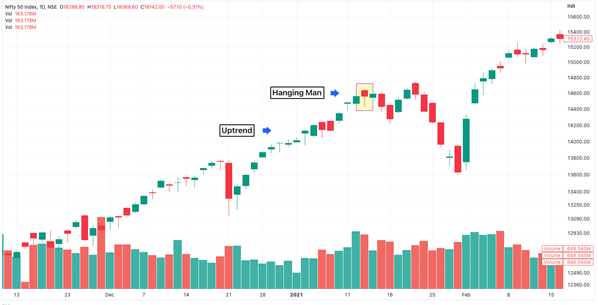
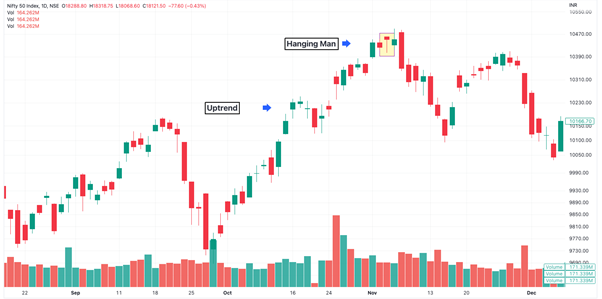
3. Inverted hammer
An "inverted hammer" is a bullish candlestick pattern that can potentially indicate a reversal in a downtrend. The candle has a small body, a long upper wick and a small or non-existent lower wick. This candlestick marks potential trend reversals but requires confirmation before action.
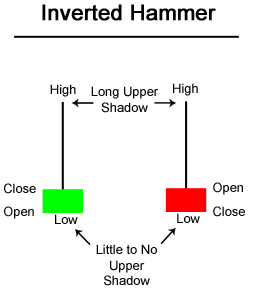
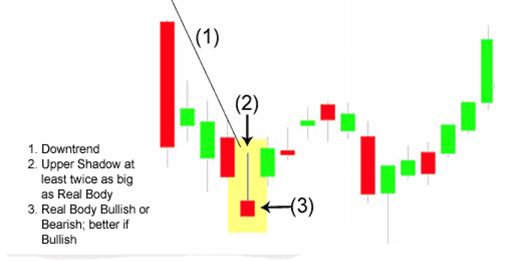
Market view
Inverted Hammers indicate a possible trend reversal or support levels. The long upper wick, which follows a decline, signals buying pressure during the session. The bulls, however, were unable to maintain this buying pressure, and prices closed substantially below their highs, resulting in a lengthy upper wick. This failure calls for bullish confirmation before taking any further action. Bullish confirmation could be provided by an Inverted Hammer supported by a gap-up or a long green candlestick with high volume.
Criteria
- The candlestick must have a small real body near the upper end of the range for the day.
- The candlestick must have a long upper wick, at least twice the length of the body.
- The lower wick should be small or non-existent.
- The candlestick must occur after a downtrend.
Trade setup
- A gap down from the close of the prior day creates the conditions for a more strong reversal
- To confirm, a positive day is required the following day to confirm this signal
4. Shooting star
The "shooting star" pattern appears at the peak of an uptrend; its long upper wick indicates that resistance to further bullish movement has been observed above the close, and a bearish reversal is possible.
The Shooting Star, as its name implies, is a bearish reversal pattern that develops following an advance and in the star position.
Market view
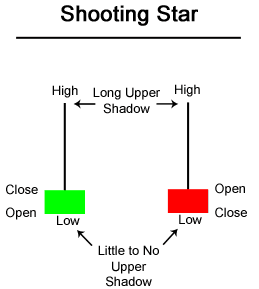
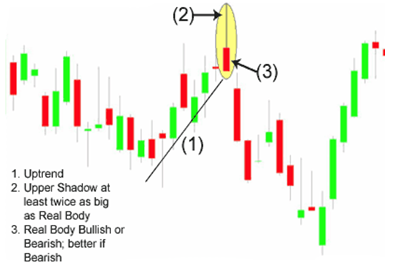
When prices open with a gap up, rise throughout the trading day, and close far from their highs, a shooting star is formed. The resulting candlestick has a small, green or red body and a long upper wick. To indicate a substantial reversal, the upper wick is relatively long and at least 2 times the length of the body. The long upper shadow suggests that buyers were able to push prices higher during the trading session, but selling pressure eventually overwhelmed them, causing prices to close near the session low. This indicates that the bullish momentum may be fading, and bears may be gaining control.
Criteria
- The candlestick must have a small real body near the lower end of the range for the day.
- The candlestick must have a long upper shadow, at least twice the length of the body.
- The lower shadow should be small or non-existent.
- The candlestick must occur after an uptrend.
Trade setup
- The longer the upper wick, the higher the chances of a reversal occurring.
- A gap up from the previous day's close sets up for a stronger reversal move provided the day after the Shooting Star opens lower.
- Large volume on Shooting Star day increases the chances that a blow-off day has occurred, although it is not a necessity.
- The following day should confirm the Shooting Star signal with a red candle or a gap down with a lower close
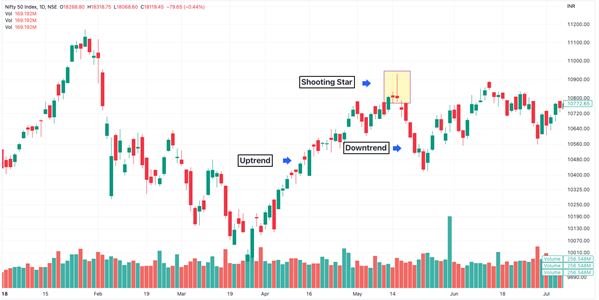
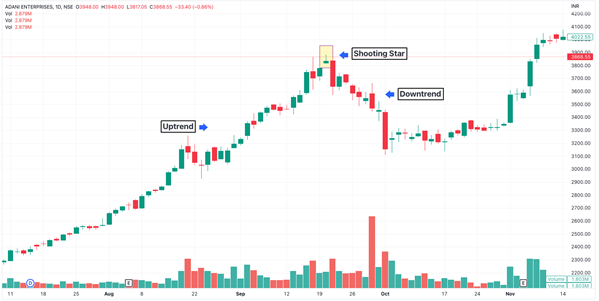
5. Marubozu
A "marubozu" represents a strong continuation of the current trend. Marubozu does not have upper or lower wicks, and the high and low are represented by the open or close.
Market view
A green Marubozu forms when open=low and close=high. This indicates that buyers controlled the price action from the first trade to the last trade. Red Marubozu forms when the open=high and close=low. This indicates that sellers controlled the price action from the first trade to the last trade.
Criteria
- The candlestick must have a long real body with little or no wicks on either end.
- The candle can be green or red, and it can appear anywhere on the chart.
- A green Marubozu moves upward and is very bullish, and a red Marubozu moves downward and is very bearish.
- The longer the candle is, the more dramatic the jump in price has been (whether it jumped up or down).
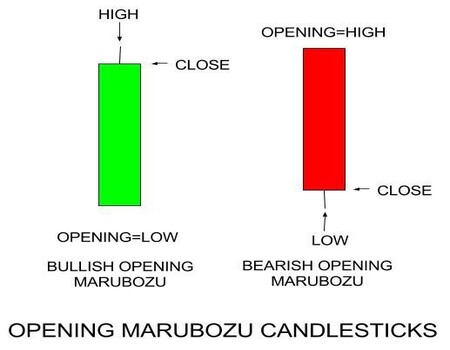
Trade setup
- As marubozu indicates
- a continuation of the trend, therefore a green marubozu candle indicates bullishness and a red marubozu candle indicates bearishness in the market.
- In case of an uptrend, it is advisable to enter a trade around the closing price of a bullish marubozu and keep the stoploss at the low of the marubozu candle.
- In case the markets moves in the opposite direction, exit the trade if price breakes the low of the marubozu.
- In a bearish market, sell around the closing price of a bearish or red marubozu and setting the stoploss at the high of the marubozu candle.
- A short marubozu candle signals subdued activity in the market, whereas a long marubozu candle signals extreme market activity.
6. Spinning top
Candlesticks with a long upper wick, long lower wick, and small real body are called spinning tops and typically represents indecision in the market.
Market view
The small body (whether red or green) of the candle indicates little movement from open to close, and the wicks indicate that both bulls and bears were active during the session. Despite the fact that the trading session opened and closed with little change, prices moved considerably higher and lower in the meantime. As a result, there was a standoff because neither buyers nor sellers could gain the upper hand. A spinning top after a long green candlestick denotes the bulls' weakness and hints at a potential trend change or interruption. Similarly, a spinning top after a long red candlestick denotes the bears' weakness and hints at a potential trend change or interruption
Criteria
- The candlestick must have a small body, with upper and lower wicks of roughly equal length.
- The candlestick must open and close near the same level.
- A substantially shorter body surrounded on both sides by two long candlestick wicks.
- It forms at the peak of an uptrend, the bottom of a downtrend, or in the middle of a trend. It can be a bearish or bullish candle.
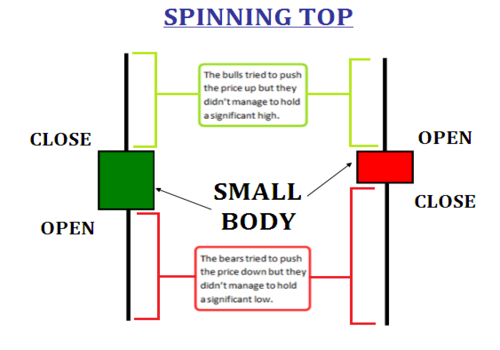
Trade setup
- Since the spinning top pattern indicates indecision, it's important to wait for confirmation before taking any trading action.
- Place a stop-loss below the low of the spinning top pattern if planning to go long or above the high of the pattern if planning to go short.
- If the spinning top pattern forms at a key support or resistance level, look for a break of that level to confirm a potential trend reversal. For example, if the spinning top forms at a key resistance level, a break of that resistance level could signal a bullish breakout.
- The spinning top pattern can also signal a period of consolidation in the market, where the price is trading within a range. In this case, look to trade the range by buying at the support level and selling at the resistance level.
7. Doji
- Doji are a type of candlestick that provides information both on its own and as part of a number of important patterns. However, on its own doji is considered a neutral pattern.
- A doji is like a cross or a plus sign which is formed when the open and close price are nearly equal and the length of the upper and lower wicks vary
- Any bias, whether bullish or bearish, is based on past price action and potential future confirmation.
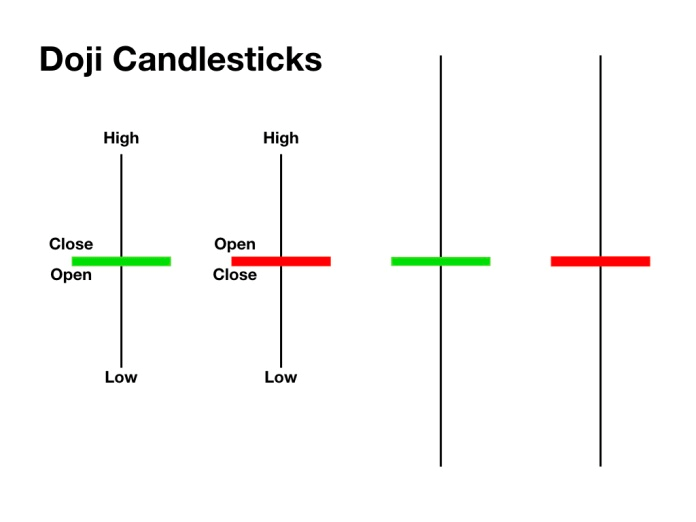
Market view
- Doji represent a tug-of-war or a sense of indecision between buyers and sellers. During the session, the prices move above and below but close at or near the opening level.
- The significance of a doji is determined by the preceding trend or candlesticks.
- Following a long green candlestick, a doji indicates that buying pressure is beginning to wane.
- After a long red candlestick, a doji signals that selling pressure is starting to diminish.
- The reason for the doji’s negative implications in an uptrend is because a doji represents indecision. Indecision among bulls will not maintain the uptrend. If the market has had an extended rally or is overbought, then the formation of a doji could mean the scaffolding of buyers’ support will give way.
- Doji are also valued for their ability to show reversal potential in downtrends. The reason may be that a doji reflects a balance between buying and selling forces.
Criteria
- The open and close of a doji should ideally, but not always, be equal.
- You should give more importance to the essense of the doji candlestick, for example a doji formed among candlesticks with long bodies would be given more importance than a doji formed with small bodies.
Trade setup
- A further downside is required following a doji for bearish confirmation. This may come as a gap down, long red candlestick, or decline below the long green candlestick's open. Traders should be on the lookout for a potential evening doji star after a long green candlestick and doji.
- Bullish confirmation could come from a gap up, long green candlestick or advance above the long red candlestick's open. Traders should be on the lookout for a potential morning doji star after a long red candlestick and doji.
- If there are many doji on a particular chart, one should not view the emergence of a new doji in that particular market as a meaningful development. That is why candlestick analysis usually should not use intra-day charts of less than 30 minutes. Less than 30 minutes and many of the candlestick lines become doji or near doji.
Key takeaways
- In general, the length of a candlestick's body indicates the strength of the buying or selling pressure. Short candlesticks, on the other hand, signify consolidation and show little price movement.
- Candlesticks with short wicks indicate that most of the trading action was confined near the open and close. Candlesticks with long wicks show that prices extended well past the open and close.
- It's important to note that no single indicator can guarantee a successful trade, and traders should use multiple indicators to confirm their trading decisions.
- Additionally, it's important to manage risk by setting appropriate stop-loss orders and position sizing.
FAQs on Candlestick Patterns
What does the length of a candlestick indicate?
In general, the length of a candlestick's body indicates the strength of the buying or selling pressure. Long candlesticks represent large price movements from opening to closing price. Short candlesticks, on the other hand, signify consolidation and show little price movement. Candlesticks with short wicks indicate that most of the trading action was confined near the open and close. Candlesticks with long wicks show that prices extended well past the open and close.
What is the most accurate candlestick pattern?
Always remember to use various candlestick patterns and indicators in order to support your research and trading strategy before buying a security.
What is the 3-Candle rule in trading?
The Three Candlestick rule is a trading strategy used to identify future price movements by examining the last three candles in a chart. It helps gauge market sentiment and potential reversals.
How do you read a candlestick chart?
The x-axis on the chart represents the timeframe, which you can adjust based on the scope of your analysis (for example, you can check a 1-day chart for short-term analysis and switch to a 1-year chart for a longer-term analysis). The y-axis, on the other hand, stands for the price levels the stock touched.
Each candlestick represents the rise or fall in price of a stock in any given time period (this time period can also be adjusted). And under the pattern you can also view the degree of volume being traded at that particular time and price. The taller the bar, the higher the volume traded.
What is the 5 Candle rule?
This rule requires identifying a specific candlestick pattern over a 5-day period, with the fifth candle serving as an entry and exit signal.
Which candle is best for intraday?
There’s no specific candle that can be classified as being the “best” for intraday trading. Intraday trading in itself can be profitable with the right candlesticks, but their performance is also influenced by market sentiment. To minimize risks, it's recommended to use technical indicators alongside candlestick patterns to be surer about your analysis. Oh, and don’t forget using stop-loss to minimize your risk quotient.
 Top Mutual Funds
Top Mutual Funds








COMMENT (0)